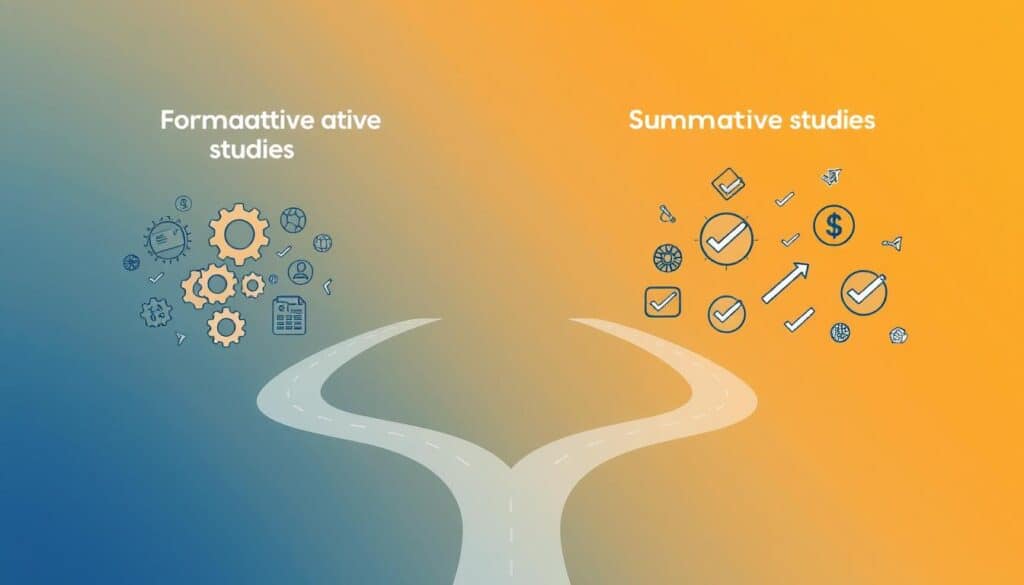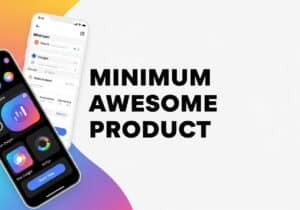Have you ever wondered why some products are a joy to use while others aren’t? It all boils down to usability research. Before a product hits the market, it should be thoroughly tested for user experience. This ensures it meets high usability standards. But, choosing the right evaluation, formative or summative, is key.
Formative and summative usability tests play different roles in making a product. Formative testing helps improve the product during early design stages. On the other hand, summative testing checks if a nearly-final product is effective, efficient, and satisfying. Knowing when and how to use these methods is critical for your product’s success.
Key Takeaways
- Formative usability tests should be conducted at least twice during a design cycle, focusing on design improvement.
- Early formative tests with wireframe prototypes typically involve 5-8 users.
- Formative testing on Minimum Viable Products (MVPs) is essential just before the development phase, also with 5-8 users.
- Summative usability tests, done with 15-20 users, validate the product against usability metrics.
- Formative evaluations are ongoing and shape the design, while summative evaluations offer final validation and benchmarking.
- Both types of evaluations can be either qualitative or quantitative, depending on research goals.
- Combining both methodologies ensures a comprehensive assessment over time and against competitors.
Introduction to Usability Studies
Usability studies are key for making products that work well for users. They use usability testing techniques and usability evaluation methods. This ensures products are up to par and run smoothly. These studies are split into formative and summative phases. Each has its own goals and ways of doing things.
Understanding Usability Testing
Usability testing watches users work with a product to find tough spots. Using different usability testing techniques, researchers get valuable feedback. Formative usability testing happens early on with 5-7 users. It’s quicker and cheaper than summative tests. Summative usability testing involves 15-20 users. It checks the final product and is generally more expensive.
The Importance of Usability Studies in Product Development
Using usability evaluation methods in product development is vital. They catch design issues early and match the product with user needs. For instance, evaluations from Human Factors Engineers offer objective insights. This helps avoid internal bias and catches mistakes. This way, the product appeals to a wider audience. Focusing on both usability testing types increases user trust, reduces problems after launch, and boosts market presence.
Next, let’s look at how formative and summative usability testing differ:
| Characteristic | Formative Usability Testing | Summative Usability Testing |
|---|---|---|
| Number of Users | 5-7 | 15-20 |
| Stage | Early design and development | Post-market launch |
| Cost | Less expensive | More costly |
| Time Consumption | Less time-consuming | More time-consuming |
| Data Type | Qualitative | Quantitative |
| Evaluator | Internal or external | External recommended |
What is Formative Usability Testing?
Formative usability testing helps improve products early in the design process. It uses user feedback to fix problems. This makes the product meet user needs better.

Definition and Objectives
It evaluates a product in the design stage. The main goals are:
- Identifying and addressing usability issues early.
- Using qualitative usability studies to gather in-depth insights.
- Ensuring the product’s design meets user demands.
- Testing with wireframe prototypes or Minimum Viable Products (MVPs).
This testing typically involves 5-8 users.
When to Conduct Formative Usability Testing
It is advised to do two rounds of tests during design. These tests are needed:
- As soon as an early prototype is available, such as wireframes or MVPs.
- Before any significant design decisions are finalized.
- Repeatedly, as the design evolves to ensure continuous usability improvement.
Examples and Applications
Different techniques and tools are used, including:
- Low-fidelity prototypes: to gather initial feedback using paper or static pages.
- Real-time observation: to see how users interact with the product.
- Pilot studies: preliminary tests to fix technology or workflow issues.
Here is a comparison of formative and summative usability tests:
| Aspect | Formative Testing | Summative Testing |
|---|---|---|
| Focus | Qualitative insights | Quantitative metrics |
| Timing | Early in development | End of development cycle |
| Sample Size | 5-8 users | 15-20 users |
| Prototypes | Wireframes, MVPs | Fully functional products |
What is Summative Usability Testing?
Summative Usability Testing is key in user-centered design. It checks a product’s effectiveness and efficiency after development. Quantitative measures confirm if usability goals are met before the product launch.
Definition and Objectives
It involves assessing the overall design with several users, usually between 15-20. The main goal is to measure how effective, efficient, and satisfying a product is for the users.
When to Conduct Summative Usability Testing
This testing phase is done right before a product’s release. It ensures all usability marks are met. Metrics like task completion rates and satisfaction are key.
Formative versus Summative Studies in Usability
Knowing the difference between formative and summative usability studies is key for product development. Formative and summative usability tests have different goals. They are used at different times in the development process. Formative testing is about exploring early design stages. It aims to find and fix issues early. Common tools for this are heuristic evaluation, interviews, and contextual analysis.

Formative testing usually involves small groups. About 4-5 people per user group work with early designs like wireframes. This phase focuses on qualitative data. It looks at what users do, think, and feel in real-time. The benefits include spotting problems early, making design better over time, improving user experience, and lowering development risks.
In contrast, summative usability testing happens near the end of developing a product. Its goal is to check if the product is easy to use. Usually, 15-20 people per user group take part in this testing. Tests measure things like how long tasks take, completion rates, and overall success. This method involves careful collection of data with specific measurements.
The comparison between these two types of testing shows why both are important. Formative testing helps make designs better early on with feedback. Summative testing checks if the final product meets usability goals before it goes out. Using both types of tests can make a product more user-friendly and successful.
| Aspect | Formative Usability Testing | Summative Usability Testing |
|---|---|---|
| Purpose | Exploratory, to shape design early | Confirmatory, to validate final product |
| When Conducted | Early stages (concept, prototype testing) | End stages (right before/after redesign) |
| Participants | 4-5 per user group | 15-20 per user group |
| Common Methods |
|
|
| Data Type | Qualitative (observations, thought processes) | Quantitative (task completion time, errors) |
Formative and summative usability studies are both valuable. Formative testing ensures problems are found and fixed early. This makes design better and more efficient. Summative testing, on the other hand, makes sure the final product has been properly checked. It confirms usability before the product goes to market.
Order and...
You have read 40% of the article. The rest is for our community. Already a member? Log in
(and also to protect our original content from scraping bots)
Innovation.world community
Login or Register (100% free)
View the rest of this article and all members-only content and tools.
Only real engineers, manufacturers, designers, marketers professionals.
No bot, no hater, no spammer.
FAQ
What are Formative Usability Studies?
Formative usability studies happen early in the design phase. They help find problems and test solutions. These tests focus on improving the design with user feedback.
What are Summative Usability Studies?
Summative usability studies evaluate a fully developed product. They check if the product is effective and efficient, using numbers to ensure it meets usability goals.
When should Formative Usability Testing be conducted?
It’s best to start formative testing early in product development. This catches design problems soon, making sure the product does what users want.
When should Summative Usability Testing be conducted?
Summative testing happens after the product is done. It’s the last step to make sure the product meets all usability requirements before going to market.
What is the key difference between Formative and Summative Usability Studies?
The main difference is their purpose and timing. Formative testing is for shaping the design early on, while summative testing checks the final product’s usability before launch.
What are the benefits of conducting usability studies?
Usability studies make users happier, save on redesign costs, and improve market position. They find design issues early and ensure the final product meets user needs.
Which industries benefit from usability studies?
Technology, healthcare, and retail industries get a lot from usability studies. They make products easier and more enjoyable to use, fitting exactly what users need.
Are both formative and summative usability studies always necessary?
Whether you need both tests depends on your product, industry rules, and your goals. Think about how complex your product is and its impact on users. Some industries require specific tests by law.
How long do usability studies typically last?
Study length changes based on what you’re testing. Formative studies are usually short and repeated. Summative studies take longer because they’re more detailed.
Who should conduct usability studies?
Experts like UX/UI designers, usability specialists, and psychologists should do these studies. They’re good at spotting design problems and knowing what users like.
External Links on Formative and Summative Usability Studies
International Standards
(hover the link to see our description of the content)
Glossary of Terms Used
International Organization for Standardization (ISO): a non-governmental international body that develops and publishes standards to ensure quality, safety, efficiency, and interoperability across various industries and sectors, facilitating global trade and cooperation. Established in 1947, it comprises national standardization organizations from member countries.
Minimum Viable Product (MVP): a basic version of a product that includes only essential features necessary to satisfy early adopters and gather feedback for future development. It aims to validate hypotheses about customer needs with minimal resources and time investment.
User experience (UX): the overall satisfaction and perception of a user when interacting with a product, system, or service, encompassing usability, accessibility, design, and emotional response throughout the entire interaction process.
User Interface (UI): a system that enables interaction between users and software applications, encompassing visual elements, controls, and overall layout to facilitate user tasks and enhance experience.













Summative usability studies are great, but arent formative ones more valuable in initial design stages for preventing usability issues?
comprehensive overview
worth noting that while formative testing is often less costly and quicker, it can sometimes overlook deeper usability issues that only become apparent in more complex, real-world scenarios.
How about different industries outside of healthcare and retail ?
Interesting read! But arent formative studies more fruitful in early design stages than summative, contrary to whats suggested?
Is it feasible to say that formative studies are more pivotal in early product development than summative ones?
Related Posts
Latest Publications & Patents on Perovskites
Latest Publications & Patents on Graphene
45+ Science Tricks for Games and Marketing: Data-Driven and Statistical Tricks
Use or Abuse 25 Cognitive Biases in Product Design and Manufacturing
Revised NIOSH Lifting Equation in Bench Ergonomics
Dark Web vs Darknet vs Deep Web: 101 & More